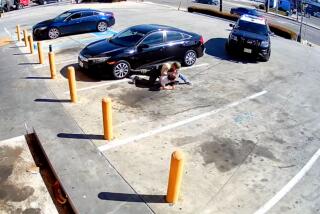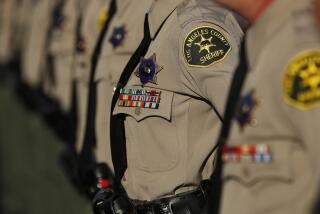8 Deputies Relieved of Duty in Suspect’s Death : Law enforcement: The officers, who are still being paid, are subjects of an internal investigation. They were involved in the shooting and beating of a man after a chase in 1990.
- Share via
Eight Los Angeles County sheriff’s deputies have been relieved of duty because of their actions in the death of a suspected kidnaper who was beaten and fatally shot two years ago, officials confirmed Friday.
The deputies, whose identities were not disclosed, were removed from their jobs with pay during an ongoing probe by the Sheriff’s Department Internal Investigations Bureau into the death of Arthur Jones, 32, after a high-speed chase.
The Kolts commission, which issued a critical report in July on the Sheriff’s Department, had cited the March, 1990, incident--although not by name--among the cases in which deputies may have used excessive force and failed to accurately report it.
But the disciplinary action was the first indication that any steps have been taken against the deputies.
“The investigation has been going on for some time and they were just recently relieved,” said Richard Shinee, an attorney for the Assn. for Los Angeles Deputy Sheriffs, which represents the officers.
Shinee would not name the deputies involved or specify the allegations against them, but he said they involve serious matters and will be challenged.
“I can say very little except that there is an investigation,” he said. “This matter is over 2 years old and has been thoroughly investigated earlier by the district attorney and the homicide bureau. I am surprised that it is still being investigated.”
In a terse statement, the Sheriff’s Department acknowledged that the deputies were relieved of duty and said the “lengthy and extremely complex” inquiry was in “its final stages.”
“The department will have additional comments when the investigation is completed,” said Sgt. Larry Lincoln, a department spokesman.
Deputies reported that they saw Jones robbing and kidnaping another man at gunpoint in Compton. After spotting the deputies, Jones allegedly shoved his victim from a moving car and attempted to escape as patrol cars pursued him on surface streets and freeways. After Jones crashed through several blockades and ran stop signs during a 10-minute chase, deputies fired a number of shots at him. Jones threw his shotgun out a car window at one point. He was hit by a bullet that fractured a vertebra.
According to a district attorney’s report, the wounded man’s car crashed into a center divider in North Long Beach and he stepped out with his hands raised. Deputies said Jones resisted and, when he suddenly moved as if to reach for a weapon, he was beaten on the head and body with a flashlight. He died a short time later in a nearby hospital.
Although the district attorney’s office concluded that there was insufficient evidence to prosecute any deputies, the report said “the injuries to Mr. Jones . . . may indicate that the force used was excessive.”
The Sheriff’s Department pursued an internal investigation that led to the disciplinary action against the eight deputies, but a spokesman declined to say when the inquiry began and what prompted it.
While the deputies were not named by the department, the district attorney’s report identified five officers who were involved in shooting at Jones and others who participated in the chase. Most were assigned to the Lynwood station, an official said.
The deputies had fired at Jones as he allegedly drove toward them or attempted to escape. The fatal bullet, which struck Jones in the cheek before fracturing his vertebra, was so deformed that it could not be determined which deputy fired the fatal round, the district attorney’s report said.
The district attorney’s Special Investigations Division concluded that the shooting was “an appropriate use of lethal force.”
One deputy struck Jones on the head and body with a flashlight. “A deputy coroner later determined that the blows . . . though serious, were not the cause of death,” said the district attorney’s report. “Jones died from the bullet wound to the vertebra. A toxicological examination also revealed that (Jones) had used cocaine.”
The Kolts report suggested that the beating of Jones, who had numerous welts on his back, may have been unnecessary after he had suffered what would turn out to be a fatal gunshot wound. The panel also said there had been “significant under-reporting of the force used” in the case.
More to Read
Sign up for Essential California
The most important California stories and recommendations in your inbox every morning.
You may occasionally receive promotional content from the Los Angeles Times.










